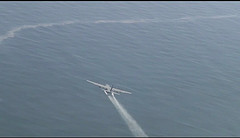 The dispersant row continues.
The dispersant row continues.
If people are worried about the legacy of what BP is doing in the Gulf of Mexico, they should watch the latest Democracy Now.
In it EPA scientist Hugh Kaufman accuses the Obama Administration, including his own agency, the EPA, of being “sock-puppets for BP in the cover up” over the true amount of oil that has been spilt and the toxic effects of the dispersant.
He argues that dispersants have saved BP millions – if not billions – by hiding the true amount of oil spilt.
Some 2 million gallons of the toxic Corexit have been used since the spill started.
Kaufman is a former US Air Force Captain who joined the EPA in its beginning stages in 1971. He also helped write the laws that are on the federal books regarding the disposal, storage, handling and treatment of solid and hazardous waste.
Though the EPA has approved the use of Corexit as an oil dispersant, Kaufman alleges that it is extremely toxic, dangerous and shows proof that the chemical was linked to health problems when used in the Exxon Valdez oil spill.
Kaufman’s allegations are extremely serious. He says that – because of the dispersants – people and wildlife that is coming in contact with Corexit are suffering internal bleeding and hemorrhaging.
He tells Democracy Now: “Consequently, we have people, wildlife—we have dolphins that are hemorrhaging. People who work near it are hemorrhaging internally. And that’s what dispersants are supposed to do. EPA now is taking the position that they really don’t know how dangerous it is, even though if you read the label, it tells you how dangerous it is.”
He continues: “And, for example, in the Exxon Valdez case, people who worked with dispersants, most of them are dead now. The average death age is around fifty. It’s very dangerous, and it’s an economic—it’s an economic protector of BP, not an environmental protector of the public.”
Kaufman asks the simple question as to who saves money from using dispersants and the answer is of course BP.
